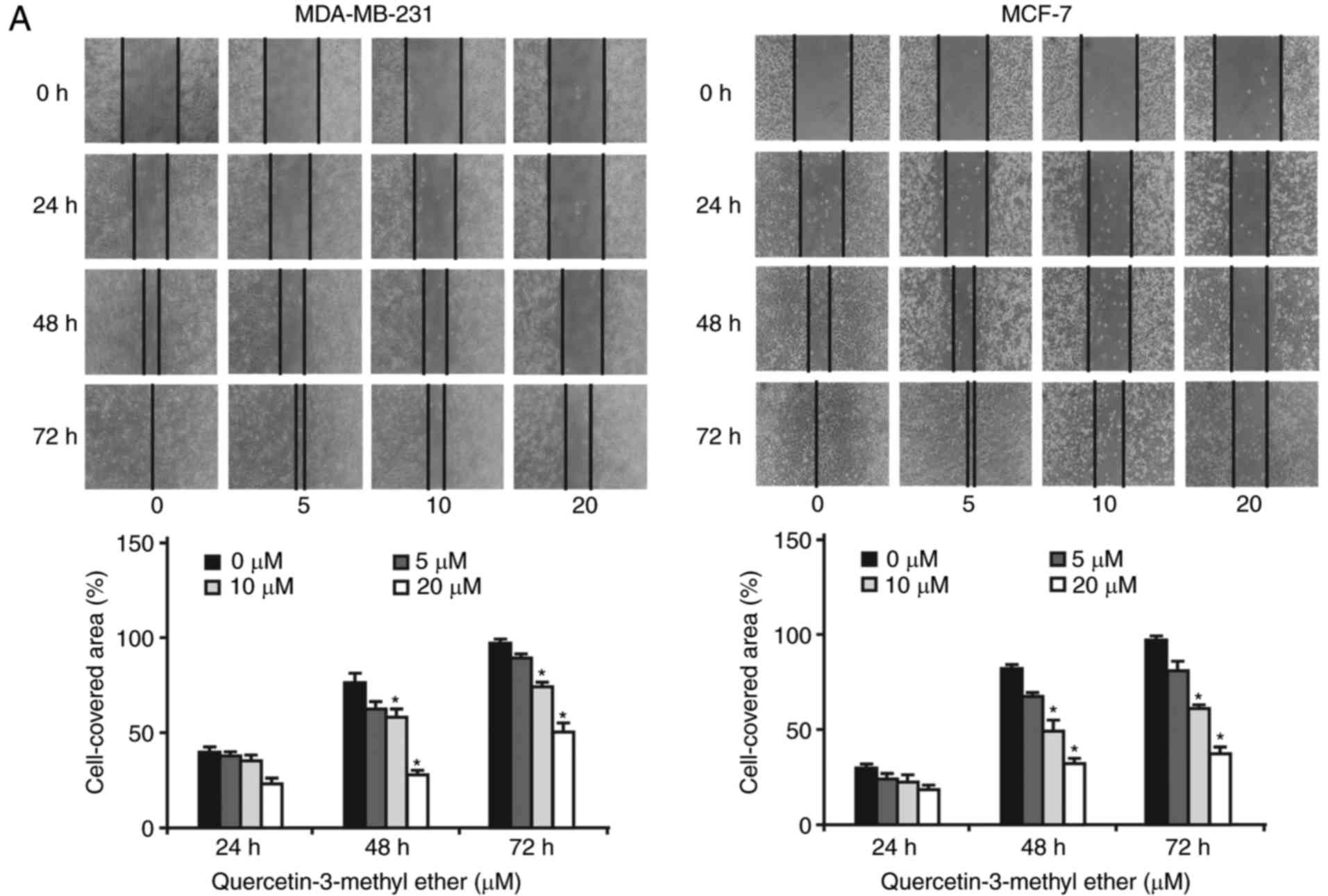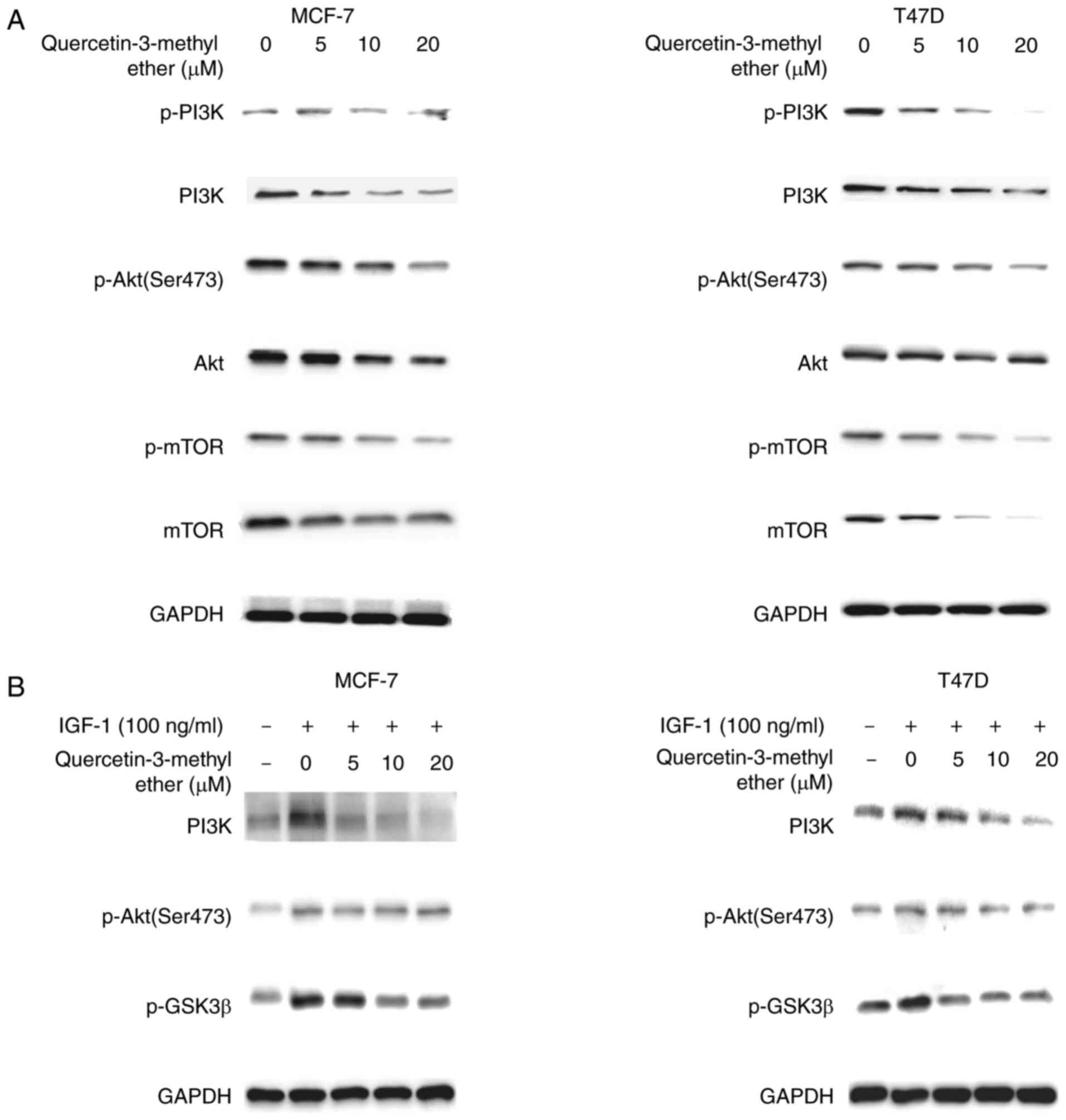|
1
|
Felipe Lima J, Nofech-Mozes S, Bayani J
and Bartlett JM: EMT in breast carcinoma-A review. J Clin Med.
5:E652016. View Article : Google Scholar : PubMed/NCBI
|
|
2
|
Siegel RL, Miller KD and Jemal A: Cancer
statistics, 2015. CA Cancer J Clin. 65:5–29. 2015. View Article : Google Scholar : PubMed/NCBI
|
|
3
|
Wu Y, Sarkissyan M and Vadgama JV:
Epithelial-mesenchymal transition and breast cancer. J Clin Med.
5:E132016. View Article : Google Scholar : PubMed/NCBI
|
|
4
|
Wang Y and Zhou BP: Epithelial-mesenchymal
transition in breast cancer progression and metastasis. Chin J
Cancer. 30:603–611. 2011. View Article : Google Scholar : PubMed/NCBI
|
|
5
|
Asiedu MK, Beauchamp-Perez FD, Ingle JN,
Behrens MD, Radisky DC and Knutson KL: AXL induces
epithelial-to-mesenchymal transition and regulates the function of
breast cancer stem cells. Oncogene. 33:1316–1324. 2014. View Article : Google Scholar
|
|
6
|
Czerwinska P and Kaminska B: Regulation of
breast cancer stem cell features. Contemp Oncol. 19:A7–A15.
2015.
|
|
7
|
Zhao Z, Lu P, Zhang H, Xu H, Gao N, Li M
and Liu C: Nestin positively regulates the Wnt/β-catenin pathway
and the proliferation, survival and invasiveness of breast cancer
stem cells. Breast Cancer Res. 16:4082014. View Article : Google Scholar
|
|
8
|
Geng SQ, Alexandrou AT and Li JJ: Breast
cancer stem cells: Multiple capacities in tumor metastasis. Cancer
Lett. 349:1–7. 2014. View Article : Google Scholar : PubMed/NCBI
|
|
9
|
Bao B, Wang Z, Ali S, Kong D, Li Y, Ahmad
A, Banerjee S, Azmi AS, Miele L and Sarkar FH: Notch-1 induces
epithelial-mesenchymal transition consistent with cancer stem cell
phenotype in pancreatic cancer cells. Cancer Lett. 307:26–36. 2011.
View Article : Google Scholar : PubMed/NCBI
|
|
10
|
Clementz AG, Rogowski A, Pandya K, Miele L
and Osipo C: NOTCH-1 and NOTCH-4 are novel gene targets of PEA3 in
breast cancer: Novel therapeutic implications. Breast Cancer Res.
13:R632011. View
Article : Google Scholar : PubMed/NCBI
|
|
11
|
Zhong Y, Shen S, Zhou Y, Mao F, Lin Y,
Guan J, Xu Y, Zhang S, Liu X and Sun Q: NOTCH1 is a poor prognostic
factor for breast cancer and is associated with breast cancer stem
cells. Onco Targets Ther. 9:6865–6871. 2016. View Article : Google Scholar : PubMed/NCBI
|
|
12
|
Callahan R and Raafat A: Notch signaling
in mammary gland tumorigenesis. J Mammary Gland Biol Neoplasi.
6:23–36. 2001. View Article : Google Scholar
|
|
13
|
Reedijk M, Odorcic S, Chang L, Zhang H,
Miller N, McCready DR, Lockwood G and Egan SE: High-level
coexpression of JAG1 and NOTCH1 is observed in human breast cancer
and is associated with poor overall survival. Cancer Res.
65:8530–8537. 2005. View Article : Google Scholar : PubMed/NCBI
|
|
14
|
Farnie G and Clarke RB: Mammary stem cells
and breast cancer-role of Notch signalling. Stem Cell Rev.
3:169–175. 2007. View Article : Google Scholar : PubMed/NCBI
|
|
15
|
Palomero T, Dominguez M and Ferrando AA:
The role of the PTEN/AKT Pathway in NOTCH1-induced leukemia. Cell
Cycle. 7:965–70. 2008. View Article : Google Scholar : PubMed/NCBI
|
|
16
|
Marty B, Maire V, Gravier E, Rigaill G,
Vincent-Salomon A, Kappler M, Lebigot I, Djelti F, Tourdès A,
Gestraud P, et al: Frequent PTEN genomic alterations and activated
phosphatidylinositol 3-kinase pathway in basal-like breast cancer
cells. Breast Cancer Res. 10:R1012008. View
Article : Google Scholar : PubMed/NCBI
|
|
17
|
Baselga J: Targeting the
phosphoinositide-3 (PI3) kinase pathway in breast cancer.
Oncologist. 16(Suppl 1): S12–S19. 2011. View Article : Google Scholar
|
|
18
|
Singh JK, Farnie G, Bundred NJ, Simões BM,
Shergill A, Landberg G, Howell SJ and Clarke RB: Targeting CXCR1/2
significantly reduces breast cancer stem cell activity and
increases the efficacy of inhibiting HER2 via HER2-dependent and
-independent mechanisms. Clin Cancer Res. 19:643–656. 2013.
View Article : Google Scholar
|
|
19
|
Hernandez-Aya LF and Gonzalez-Angulo AM:
Targeting the phosphatidylinositol 3-kinase signaling pathway in
breast cancer. Oncologist. 16:404–414. 2011. View Article : Google Scholar : PubMed/NCBI
|
|
20
|
Kleer CG, Cao Q, Varambally S, Shen R, Ota
I, Tomlins SA, Ghosh D, Sewalt RG, Otte AP, Hayes DF, et al: EZH2
is a marker of aggressive breast cancer and promotes neoplastic
transformation of breast epithelial cells. Proc Natl Acad Sci USA.
100:11606–11611. 2003. View Article : Google Scholar : PubMed/NCBI
|
|
21
|
Inari H, Suganuma N, Kawachi K, Yoshida T,
Yamanaka T, Nakamura Y, Yoshihara M, Nakayama H, Yamanaka A, Masudo
K, et al: Expression of enhancer of zeste homolog 2 correlates with
survival outcome in patients with metastatic breast cancer:
Exploratory study using primary and paired metastatic lesions. BMC
Cancer. 17:1602017. View Article : Google Scholar : PubMed/NCBI
|
|
22
|
Pourakbar S, Pluard TJ, Accurso AD and
Farassati F: Ezh2, a novel target in detection and therapy of
breast cancer. Onco Targets Ther. 10:2685–2687. 2017. View Article : Google Scholar : PubMed/NCBI
|
|
23
|
Rubio S, Quintana J, Eiroa JL, Triana J
and Estévez F: Acetyl derivative of quercetin 3-methyl
ether-induced cell death in human leukemia cells is amplified by
the inhibition of ERK. Carcinogenesis. 28:2105–2113. 2007.
View Article : Google Scholar : PubMed/NCBI
|
|
24
|
Lee EH, Kim HJ, Song YS, Jin C, Lee KT,
Cho J and Lee YS: Constituents of the stems and fruits of Opuntia
ficus-indica var. saboten. Arch Pharm Res. 26:1018–1023. 2003.
View Article : Google Scholar
|
|
25
|
Takeara R, Albuquerque S, Lopes NP and
Lopes JL: Trypanocidal activity of Lychnophora staavioides Mart.
(Vernonieae, Asteraceae). Phytomedicine. 10:490–493. 2003.
View Article : Google Scholar : PubMed/NCBI
|
|
26
|
Wei BL, Lu CM, Tsao LT, Wang JP and Lin
CN: In vitro anti-inflammatory effects of quercetin 3-O-methyl
ether and other constituents from Rhamnus species. Planta Med.
67:745–747. 2001. View Article : Google Scholar : PubMed/NCBI
|
|
27
|
Kumar AD, Bevara GB, Kaja LK, Badana AK
and Malla RR: Protective effect of 3-O-methyl quercetin and
kaempferol from Semecarpus anacardium against
H2O2 induced cytotoxicity in lung and liver
cells. BMC Complement Altern Med. 16:3762016. View Article : Google Scholar
|
|
28
|
Martino R, Arcos ML, Alonso R, Sülsen V,
Cremaschi G and Anesini C: Polyphenol-rich fraction from Larrea
divaricata and its main flavonoid quercetin-3-methyl ether induce
apoptosis in lymphoma cells through nitrosative stress. Phytother
Res. 30:1128–1136. 2016. View Article : Google Scholar : PubMed/NCBI
|
|
29
|
Li J, Mottamal M, Li H, Liu K, Zhu F, Cho
YY, Sosa CP, Zhou K, Bowden GT, Bode AM, et al: Quercetin-3-methyl
ether suppresses proliferation of mouse epidermal JB6 P+ cells by
targeting ERKs. Carcinogenesis. 33:459–465. 2012. View Article : Google Scholar :
|
|
30
|
Li J, Zhu F, Lubet RA, De Luca A, Grubbs
C, Ericson ME, D'Alessio A, Normanno N, Dong Z and Bode AM:
Quercetin-3-methyl ether inhibits lapatinib-sensitive and
-resistant breast cancer cell growth by inducing G2/M
arrest and apoptosis. Mol Carcinog. 52:134–143. 2013. View Article : Google Scholar
|
|
31
|
Kim HY, Lee KM, Kim SH, Kwon YJ, Chun YJ
and Choi HK: Comparative metabolic and lipidomic profiling of human
breast cancer cells with different metastatic potentials.
Oncotarget. 7:67111–67128. 2016.PubMed/NCBI
|
|
32
|
Gonzalez ME, Moore HM, Li X, Toy KA, Huang
W, Sabel MS, Kidwell KM and Kleer CG: EZH2 expands breast stem
cells through activation of NOTCH1 signaling. Proc Natl Acad Sci
USA. 111:3098–3103. 2014. View Article : Google Scholar : PubMed/NCBI
|
|
33
|
Armstrong AJ, Marengo MS, Oltean S, Kemeny
G, Bitting RL, Turnbull JD, Herold CI, Marcom PK, George DJ and
Garcia-Blanco MA: Circulating tumor cells from patients with
advanced prostate and breast cancer display both epithelial and
mesenchymal markers. Mol Cancer Res. 9:997–1007. 2011. View Article : Google Scholar : PubMed/NCBI
|
|
34
|
Lombaerts M, van Wezel T, Philippo K,
Dierssen JW, Zimmerman RM, Oosting J, van Eijk R, Eilers PH, van de
Water B, Cornelisse CJ, et al: E-cadherin transcriptional
downregulation by promoter methylation but not mutation is related
to epithelial-to-mesenchymal transition in breast cancer cell
lines. Br J Cancer. 94:661–671. 2006. View Article : Google Scholar : PubMed/NCBI
|
|
35
|
Zhu H, Bhaijee F, Ishaq N, Pepper DJ,
Backus K, Brown AS, Zhou X and Miele L: Correlation of Notch1, pAKT
and nuclear NF-κB expression in triple negative breast cancer. Am J
Cancer Res. 3:230–239. 2013.
|
|
36
|
Meurette O, Stylianou S, Rock R, Collu GM,
Gilmore AP and Brennan K: Notch activation induces Akt signaling
via an auto-crine loop to prevent apoptosis in breast epithelial
cells. Cancer Res. 69:5015–5022. 2009. View Article : Google Scholar : PubMed/NCBI
|














